
Project 667A nuclear missile attack submarines
 Project 667A Navaga, Project 667AU Nalim: 32 ballistic submarines (Yankee I). Later Project 667АМ “Navaga-М” (Yankee-II), 667АТ “Груша”, 667М “Андромеда” (Yankee Notch), 667АК “Аксон-1” (Yankee Pod), project 09780 “Аксон-2” (Yankee Big Nose), Project 09774/667АН (Yankee Stretch)
Project 667A Navaga, Project 667AU Nalim: 32 ballistic submarines (Yankee I). Later Project 667АМ “Navaga-М” (Yankee-II), 667АТ “Груша”, 667М “Андромеда” (Yankee Notch), 667АК “Аксон-1” (Yankee Pod), project 09780 “Аксон-2” (Yankee Big Nose), Project 09774/667АН (Yankee Stretch)
Soviet Cold War Subs
Pr.613 Whiskey | Pr.611 Zulu | Pr.615 Quebec | Pr.633 Romeo | Pr.651 Juliet | Pr.641 Foxtrot | Pr.641 buki Tango | Pr.877 KiloPr.627 kit November | Pr.659 Echo I | Pr.675 Echo II | Pr.671 Victor | Pr.671 skat Charlie | Pr.705 lira Alfa | Pr.949 antey Oscar | Pr.945 barrakuda Sierra | Pr.971 bars Akula | Pr.885 graney Yasen | Pr. 545 Laika
Pr.629 Golf | Pr.658 Hotel | Pr.667A Yankee | Pr.667B Murena Delta I | Pr.667D Delta II | Pr.667BDR Kalmar Delta III | Pr.667 BDMR delfin Delta IV | Pr. 941 akula Typhoon | Pr.995 borei Dolgorukiy | Pr.09851 Khabarovsk
Project 667A (NATO Yankee I) class submarines were the first Soviet ballistic missile submarines comparable to their U.S. counterparts. They carried more missiles (buried in the hull versus in the sail) and were considerably quieter than the previous Hotel class. They had a much smoother hull shape, new propeller design as well as exterior sound-deadening coating among others, making them the first true deterrence threat for the Pentagon. Several were later modified in sub-variants and part of the class not upgraded were decommissioned or converted as SSNs, their missile compartments cut out to comply with the START II arms-reduction treaty. They had less issues compared to the Hotel/Echo/November 1st generation, yet still, by 1986 K-219 experienced a missile-fuel leak causing an explosion and fire killing four, and she sank off the U.S. East Coast. All 32 “Yankee class” were gradually replaced by more modern “Delta” series and ultimately the Typhoon.
Note that “Project 667” was used for a whole serie of SSBNs that went on until the Delta IV (Pr.667 BDMR delfin) in the 1990s.
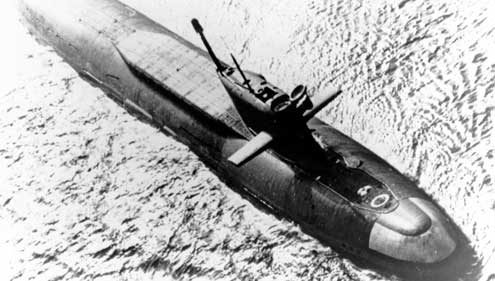
Development
Work on creating a second-generation submarine missile carrier began in 1958 at TsKB-18 under the leadership of chief designer A. S. Kassatsier. The main armament was initially supposed to consist of eight liquid-fuel missiles of the D-4 complex, or the same solid-fuel missiles of the D-6 complex which were developed in parallel. The final project 677 was carried out at LPMB “Rubin”, Lead Designer was S. N. Kovalev.
In 1961, development started on Project 667 submarines, which centered around hull-mounted silos for D-4 or D-6 missiles. Soon these systems had a good alternative, the small-sized “universal” single-stage liquid-propellant ballistic missile R-27 started at SKB-385 under V.P. Makeev. Preliminary research arrived by the end of 1961 to the Naval staffn abnd were possed on to the Politubro. It soon received full support so that on April 24, 1962, a government decree established the D-5 complex/R-27 rocket program development, using nitrogen tetroxide as oxidizer, and asymmetrical dimethylhydrosine (heptyl) as fuel.
The new system needed to be launched from deep underwater and needed a number of original technical solutions, as the new ballistic missile would have to be “squeezed” into a very small silo, with a volume 2.5 times smaller than ones used for the R-21 missile (Hotel class). At the same time, the R-27 had a launch range 1,180 km, much greater than its predecessor. Russian scientists at the time had remarkable feat on technology related to compactness with the filling of rocket tanks with propellant components at the manufacturing plant.
The complex behind this new ballistic missile was still intended to hit stationary ground targets due to accuracy limitations of the time, and carry a powerful thermonuclear warhead. But there was an anti-ship version developed also at the time, a world’s first, intended at striking entire task forces on the move, still nuclear. This was the the R-27K, equipped with a passive radar homing head and capable of aut-correction to the last minute to strike a moving ensemble at 30 knots and at a range of up to 900 km. But the project had lower priority as it was only tested in 1974, and never entered service. Only the diesel-electric K-102 tesyed it, Project 605, converted from Project 629 wheh the reorientation of Project 667 project as new missile system was done. The final 16 missile silos buried in the hull vertically in two rows as the US George-Washington class was seen as enough of a triumph at the time, if relalized properly. It was less from a desire for plagiarism, but to the fact that optimal hull calculations for displacement and speed.
The new SSBN was developed by TsKB MT Rubin, superstar of Soviet submarine development, and the Project 667A received the more palatable internal code “Navaga”. Kovalev became creator of almost all subsequent Soviet strategic nuclear-powered missile ships. Considerable attention was paid to her hydrodynamic refinements, with the best specialists from industry research centers (even in aviation) involved to develop the shape of it as well as mathematicians, hydrodynamicians of TsAGI, leading to countless days of intensive tests in pools, dozens of models were trialled until the very best shape was determined.
The use of sixteen ballistic missiles, instead of just three, single row for the Hotels, posed its own set of challenges, and required solutions to a number of new problems. First of all, it was necessary to sharply increase the rate of fire in order to obtained a true missile salvo in time on chosen strategic target and achieve full deterrence with one submarine. It was also necessary for the submarine to leave the launch area before an enemy ASW answer, so to have the necessary simultaneous pre-launch preparation for a salvo and the best option was to automatize all pre-launch operations to gain time. The human factor was bypassed, but this meant an unprecedented level of commitment in electronic systems that were at the very beginnings in 1962.
So chief designer R.R. Belsky, the first domestic automated information and control system “Tucha” was developed. All firing data was to be generated by a specialized computer. The navigation equipment was to be on par and supposed to ensure confident in navigation and missile launch in the polar region.
Final design and construction

Cutaway legend:
1 — main antennas of the “Kerch” system;
2 — tank for bubble-free torpedo firing system;
3 – 533 mm forward tubes
4 – annular gap tank
5 -torpedo replacement tank
6 — bow hatch
7 — bow emergency buoy
8 — spare 533 mm torpedoes
9 – torpedo loading hatch
10 — bow (torpedo) compartment
11 — bow group AB
12 — hydrodynamic log
13 — Central City Hospital
14 — capstan and capstan machine
15 — VVD cylinders
16 – second (living) compartment
17 – aft group AB
18 – repeater gyrocompass, direction finder and sextant on a gimbal
19 – periscope of the MT-70-8 system
20 – periscope PZNG-8
21 — conning tower
22 – third (central) compartment
23 – central post
24 — astrocorrector periscope;
25 — “Saiga” radio sextant
26 — “Zavesa” radio direction finder antenna
27 — radar antenna
28 — RDP
29 — SORS antenna “Zaliv-P”
30 — fourth (bow missile) compartment
31 — missile silo
32 – fifth (aft missile) compartment
33 – sixth (auxiliary mechanisms) compartment
34 — diesel fuel tanks
35 – seventh (reactor) compartment
36 – reactor
37 — steam generator
38 — heat exchange block
39 — receiver cylinders
40 — eighth (bow turbine) compartment
41 — steam turbine
42 – capacitor
43 — elastic coupling
44 — planetary gearbox
45 — main thrust bearing (GUP)
46 — oil cooler
47 — ninth (aft turbine) compartment
48 — condenser electric pump
49 — autonomous turbogenerator (ATG)
50 — pop-up camera (VSK)
51 — aft hatch
52 — rowing ED (GED)
53 — elastic coupling
54 — tenth (aft) compartment
55 — stern emergency buoy
56 — stern rudder drives.
Construction began in Severodvinsk at the end of 1964 and was carried out at an unusually fast pace. The first strategic missile submarine K-137 was laid down at the Northern Engineering Enterprise on November 9, 1964. The ship was launched (more precisely, the dock was filled with water) on August 28, 1966. On September 1st, 2 p.m., K-137 was first launched and acceptance tests began. On the same day, in presence of chief designer on board she achieved 28.3 knots at maximum turbine power, 3.3 knots higher than the designed speed. Thus, in terms of its hydrodynamic characteristics, she was not only on par with its main potential opponents, the Thresher and Sturgeon class SSNs capable of 29-30 knots.
The Project 667A submarine, like the first generation nuclear-powered ships, was of the double-hull type. The robust hull had a pressure cylinder 9.4 m in diameter, oval-shaped bow and a spindle-shaped stern, external frames and thickness of 40 mm, mainly made of AK-29 steel, divided by thick waterproof bulkheads designed to withstanding pressure of 10 kg/cm2.
The structural frames were made of AK-29 steel, 12 mm thick and symmetrical strip-bulb, welded T-profiles 330 mm high.
She was to have also a powerful demagnetization device ensuring the safety of her own magnetic field. Measures were taken to reduce the magnetic field of her outer hull as well, pressured external tanks, and all conning tower retractable devices, rudders and other protruding parts. To further reduce her electric field active compensation was created by using a galvanic pair “propeller-hull” for the first time.
Facilities comprised a moder communications suite also, suited for the medium, shortwave and ultrashortwave frequency ranges. Later Yankee class boats had the automated radio communication systems “Molniya” (1970) or “Molniya-L” (1974), developed by Chief designer A.A. Leonov. They included the first automated radio receiving device “Basalt”, providing reception on several KB channels and one SDV and the radio transmittor “Mackerel”, allowing for hidden automatic tuning to any frequency in the operating range. There was an exhaust pop-up antenna linked to the Paravane buoy to receive target designations and signals from a satellite navigation system while submerged under 50 m. She was also the first to use the classified communications equipment system for automatic message encryption transmitted via the long range antenna. The radio-electronic defense systems included the transponder radar IFF (friend or foe) “Khrom-KM” also a first for Soviet submarines, submarine) and the radar “Albatross”, search radar “Zaliv-P” (see later).
Design of the class
Hull and general design
The outer hull had its shape based on the Projet 627 Kit (November) well refined and streamlined, made of SW steel. The pressure hull was a better refined cylinder 9.4 m in diameter and made of low-magnetic steel AK-29, 40 mm (2 inches thick). Reinforcing frames were made of hardened steel symmetrical welded beams. The bulkheads were made of AK-29 steel, 12 mm (0.5 in) thick, designed for a pressure of 10 atmospheres, dividing the durable hull into ten main compartments:
1 Torpedo compartment, 2 battery compartment with living quarters and officer’s quarters; 3 the central post, power plant control panel; 4 and 5 missile compartments, 6 diesel generator compartment; 7 reactor compartment;, 8 and 9 turbine compartments; 10 electric motor compartment and tail section.
Soundproofing:
In the process of creating the pr. 667A and 667AU, a set of the global work was carried out to reduce the sound level based on phyliscal means, around the propeller, propulsion and coating. The ensemble made it possible to significantly reduce noise level for the machinery. This was possible thanks to the chosen echelon layout in development. The turbine compartments were gradually filled with various designs improved for noise reduction and ported in subsequent SSBNs, up to Project 667BDRM (Delta IV). The echelon arrangement turned out to be the most optimal in terms of survivability. An accident in one turbine compartment did not in any way affect the other turbine compartment, and the reactors could operate on any of the shaft.
The hull was covered with a special coating enabling to generate at 4 knots no more than 100-130 dB per 1 Pa at a distance of 1 meter.
Powerplant
The main power plant consisted of an OK-700 steam generating unit and two-shaft steam turbine unit (STU). The OK-700 PPU included two autonomous units, right and left, each including the following: -1 water-cooled reactor VM-4-II with a nominal power of 90 MW
-5 steam generators and their servicing systems (coolant circulation, gas removal, 3rd and 4th circuits cooling etc.).
Both were located in one reactor (seventh) compartment, in two hardware enclosures, and one after the other amidships.
After the reactor the turbines were arranged in two autonomous units, each consisting of the main turbine GTZA-635 operating directly on the shaft line, and an autonomous turbogenerator. The left side unit was located in the eighth turbine compartment, and starboard one located in the ninth turbine compartment. They could work independently but with the adjacent one in cross mode, or both at the same time for maximum survivability. Alternating current voltage was 380 V.
There was an auxiliary power plant used to start, cool down and shit the power plant, supplying electricity at all times, including when the reactor were shut down, including to provide propulsion in case of a general failure. It was also used for careful surface navigation, as including two DC diesel generators DG-460, two groups of rechargeable lead-acid batteries (112 48-SM cells each) and two PG-153 creeping reversible propulsion motors (225 kW each). They were located in the sixth compartment, first compartment for the first group, and second group in the second compartment.
The 380 V network from autonomous electric generators increased reliability of the electrical power system, increased operations autonomy, limited maintenance, and made it possible to transform the voltage for all on-board system demands if neede. There was a full display and operator.
The Two propellers were also refined and hydrodynamically refined compared to older designs for a much reduced noise level. To reduce hydroacoustic signatire, the main and auxiliary mechanisms were covered with vibration-damping rubber. The pressure hull was lined with sound-insulating rubber, and non-resonant anti-sonar and sound-insulating rubber coating was applied to the outer hull as well (see later).
In the end, the Yankee class was rated for a surface speed of 15 knots, underwater speed of 28 knots (30+ knots was only on trials), and a working diving depth of 320 m for oceanic travel, but maximum diving depth of 500 m to scape ASW attacks. The nuclear poerplant ensured unlimited range but navigation autonomy was down to 90 days if not supplied. The use of oceanic supply ships was not envisioned for them at least in peacetime, but it was not unhread of to send such ship to station on a meeting point. Satellites observation of the oceans however in the 1970-80s made it gradually more difficult. There was also the psychological aspects of a longer than three months mission for the crew.
Armament
Main: 16x SLBM
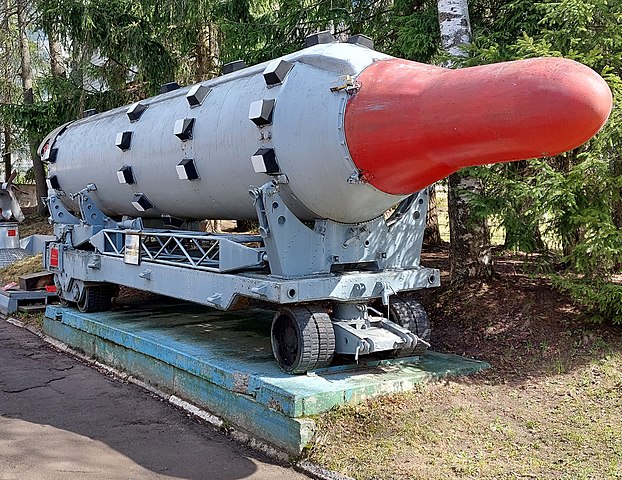
Rocket R-27 (RSM-25) in the museum of S. P. Korolev
The main armament as planned for Project 667A were sixteen 16 R-27 Zyb ballistic liquid-fuel missiles, all in vertical silos. Each weighted 14.5 tons for a range of 2,400 km. Development of the D-5 complex was carried out by TsKB-16, Makeyev Rocket Design Bureau until 1962 when it entered service, and produced to c1800 until 1968 by the Zlatoust Machine-Building Plant and Krasnoyarsk Machine-Building Plants.
The missile’s body was all-welded in hard-worked AMg6 (АМг6) aluminium-magnesium-alloy panels made in a two-step process until reaching 1/5 and 1/8 of the original plate. It was coasted with a protective heat-and moisture-resistant Asbestos compound. Instead of fins, it was steered by nozzles and protected inside the tube by several rows of rubber shock absorbers. The R-27 featured a 650-kg detachable warhead, 1 MT yeled and separated by a high-explosive linear-shaped charge. Below was the guidance instrumentation inside and hemispherical compartment, upper bulkhead of the oxidiser tank to be easy to remove and maintain.
The upper oxidiser tank and the lower fuel tank shared a common bulkhead instead to make it more compact. The onher feature was its factory fueling in “ampulization” by welding filling and drain valves. To combat corrosion seams and joints had new fabrication methods ensuring safe sealing for 5 and later 15 years.
It was powered by a 4D10 rocket engine developed from OKB-2, with a single fixed thrust chamber (23 ton-force) and two smaller gimbaled thrust chambers on the bottom of the fuel tank for 3 ton-force thrust usable for steering. It used an hypergolic propellant combination with dinitrogen tetroxide and unsymmetrical dimethylhydrazine forced in by turbopumps. The 4D10 main chamber used an oxidiser-rich staged combustion cycle and two smaller chambers used a gas-generator cycle and can throttled by regulating the single propellant line or shared oxidiser lines.
Its main chamber was integrated into the missile by permanently welding, not mounted on a thrust structure, the backdrop being the engine could not be tested alone.
The R-27 was fired underwater so the container was overpressurized, flooded, pressure equalized while the missile nozzles were housed inside of a watertight air-filled adapter connector, with the two smaller chambers ignited first, then the main chamber. It could be fore from 40-50 meters underwater, with Preparations for launch in 10 minutes, 8 seconds between launches.
The R-27 was constantly improved.
⚙ specifications R-27/R27-U |
|
| Weight | 14,200 kg (31,300 lb) *R-27K: 13,250 kg (29,210 lb) |
| Dimensions | 8.890 m (29.17 ft) x 1.500 m (4.92 ft) *R-27K: 9m (29.528 ft) |
| Propulsion | N2O4/UDMH |
| Speed | boost time 128.5 Seconds |
| Range | 2,400 km (1,500 mi) *27U 3,000 km (1,900 mi) |
| Guidance | Inertial, launcher data |
| Accuracy | CEP 1.9 km (1.2 mi)** |
| Ceiling | 620 km (390 mi) |
| Payload | Single warhead 650 kg (1,430 lb), 1 MT yield* |
*R27U: 650 kg (1,430 lb) 1 MT yield or 3x 0.2 MT Warheads 170 kg (370 lb) each
**R-27U: CEP 1.3–1.8 km (0.81–1.12 mi), R-27K: CEP 0.37 km (0.23 mi)
The launch containers measured 10.1 m for a diameter of 1.7 m, full height of the hull with 4th and 5th tcompartment located in two rows behind the sail, all fitted with external folding lids. To prevent accidents when liquid fuel components entered the silo during depressurization automated systems were activated for for irrigation, gas analysis and maintaining a microclimate within the specified parameters.
The missiles were fired from the flooded silo, at depths of 35-40 m and with sea waves up to 5 points. Initially it was planned tactically to fire four successive four-missile salvoes with an 8 s. interval, but calculations showed that as the missiles were fired, the carrier sub if nit trimmed would rapidly ascend to the to the surface so a pause was needed after the launch of the fourth missile in a salvo to regain depth by heavy trimming. After each salvo three minutes were needed to return the boat to its original depth. Between the second and third salvos, 20-35 minute delay for the same for pumping water from the annular gap tanks into the silos and trimming the ship. However, actual firing revealed it was less severe than expected, and one could launched all eight-missile salvo in one go. pr.667AU and pr.667A after modernization could fire a full eight-missile salvo and this was done as a world’s first on December 19, 1969.
Its firing sector was 20°, with latitude of the launch point not exceeding 85°.
Torpedo Armament
The torpedo armament consisted of six bow torpedo tubes, comprising four main 21-in or 533 mm caliber for both anti-sub/ship torpedoes and two 400 mm (16 inches) caliber to throw put self-propelled decoys. Total carried on board were 16 torpedoes, including two with nuclear warheads and four decoys. In special cases, an additional torpedo load of 12 could be carried by reconverting at the yard the officer’s wardroom in compartment 2. This was never done, mostly a potential wartime conversion. This would have made for a total of 28.
Four main 21-in TTs
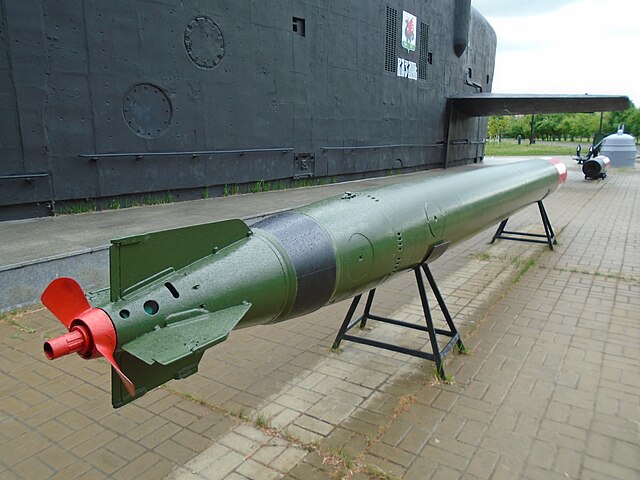
The boat’s armament consisted of four bow torpedo tubes with a caliber of 533 mm, providing a maximum firing depth of up to 100 m, as well as two bow 400 mm torpedo tubes with a maximum firing depth of 250 m. The torpedo tubes were equipped with fast loading and wire-guidance systems.
The 533 or 21 inches model were the Type or SET 53 torpedoes:
This Heavyweight torpedo entered service in 1958 and was replaced from 1964 by the SET-53M, will we go for the latter.
It was developed initially from 1950 to 1957 by NIMTI in the early phase, Gidropribor and SKB Dvigatel for the next SET-53M. This Modernized variant used a silver-zinc battery and running gear with reduced noise, with much longer range and higher speed.
⚙ specifications SET-53M |
|
| Weight | 1.480 kg |
| Dimensions | Length 7.8 m, Diameter 533 mm |
| Propulsion | PM5-3MU electric motor, T-7 lead-acid batt. |
| Range/speed setting | |
| Warhead | 150 kg (possibly 100 kg), Electromagnetic proximity fuse 5m radius |
| Guidance | Passive acoustic homing, Sensor range 400 – 600 m |
Anti-Air defence
Project 667A became the first missile carriers to receive portable anti-aircraft missile systems (MANPADS) of the Strela type, designed to defend a ship surfaced, from low-flying aircraft and helicopters.
Upgrade Yankee II: 16x SLBM
The main armament of the base Project 667A Navaga boats were 16 R-27 (RSM-25) ballistic missiles with a 1 Mt monoblock warhead and a firing range of up to 2,400 km. Rocket launch is only underwater. 6 torpedo tubes and 22 torpedoes against submarines and surface ships, 2 of them with nuclear charges.
Full details on these when rerviewing the next SSBN class.
Internal Accomodations
Project 667A boats for the first time paid attention to habitability, for crew’s comfort intended for long cruises, with an autonomous air conditioning system in each compartment which went with reductions of acoustic signatures in all combat posts and living quarters. All personnel were housed in cabins with more intimacy or small rooms. There was a large officer and for the first time, a full dining room for senior officers, which could quickly transform into a gym or cinema hall. All communications were hidden under special removable panels. The interior design was quite consistent with the requirements of the time. Paneling was used extensively also to absorb noise and humidity, making it quieter inside.
Sailors noted this significantly higher level of comfort and colorful industrially designed interiors in the style of interior wallpapers, completely hiding the former chaotic interweaving of multi-colored harnesses and pipelines all under removable panels. The general interior colors were in light gray tones making the interior very clear and lean in apperance. Incandescent lamps were replaced but toned down fluorescent lamps coming into fashion in apparel furniture at the time.
Sensors
Electronic equipment:
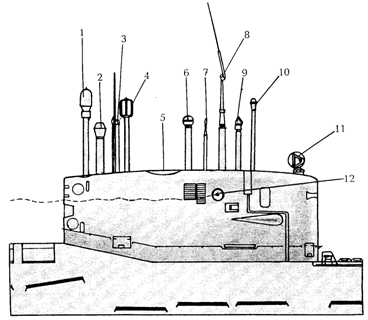
1-AP SORS “Zaliv-P”
2-PMU RDP
3-PMU VAN-S (behind it there is a PMU with AP radar “Albatross”)
4-AP radio direction finder “Zavesa-P”
5-fairing of the Saiga radio sextant shaft
6-PR-14 periscope
7-Periscope PZNG-8M
8-PMU “Iva-M”
9-Periscope MT-70-8
10-Main Periscope PZNS-8
11-Direction finder and sextant on gimbal suspension (early submarines)
12-Antenna input, VBAU “Fosfor” installed on later submarines. The antenna was manually extended and unfolded on the missile deck and after diving unfolded and retracted using a manual drive >after ascending to the surface position. Since 1972 and during modernizations, the Cyclone power unit was installed, and in later “Sintez”.
It included the following:
-Combat information and control system “Tucha”, ensuring proper use of missile and torpedoes
-Hydroacoustic complex “Kerch” (full acoustic set with displays)
-Radar complex RLK-101 “Albatross” for surface scanning, limited range against aircraft and ships
Navigation equipment:
The first four ships were armed with the Sigma navigation system. On ships built after 1972, the Tobol complex was installed instead. Late-built ships also carried the Cyclone satellite navigation system.
Tucha Underwater Guidance
The “Tucha” combat information and control system (CIUS) was the first domestic multi-purpose automated system ensuring the use of missile and torpedos. In addition it collected and processed information about the environment, as well as solved navigation problems.
For preventing great depths collision that could lead to disaster (this is believed to have been the cause of the death of the American nuclear submarine Thresher), pr.667A had for the first time a comprehensive automated control system, providing software, automated control of heading and depth, as well as stabilization. They acted automatically if needed on the front horizontal rudders located close to the bow. This solution, borrowed from US nuclear submarines, enabled trimless transition to greater depths at lower speeds, and also simplified positioning of the boat at a given depth during a missile salvo. The rear tail was a classic cross type.
Kerch system
The Main information system for underwater positioning was the Kerch hydroacoustic system, “illuminating” underwater surroundings and providing target designation data during torpedo firing, as well as mine detection, communications and detection of enemy hydroacoustic signals. The station was developed by chief designer M.M. Magid, operating in active mode by echo emission and noise direction finding modes, with a detection range of 1-20 km.
Sigma system
The first four SSBNs pr.667A had the Sigma all-latitude navigation system. It was developed in 1960 underchief designer V.I. Maslevsky. Since 1972, it was replaced by the “Tobol” (chief designer – O.V. Kishchenkov). The Sigma included an inertial navigation system, a first for the USSR, absolute hydroacoustic log measuring speed relative to the seabed, and information processing system via a digital computer. The complex ensured navigation in Arctic waters, sandwiched between pack ice and bottom, as well as ability to launch missiles at latitudes up to 85°.
It made it possible to determine and save a given course, measure the boat speed relative to the water currents, calculate geographic coordinates and provide the necessary data to other systems.
On the later boats, this was supplemented with the Cyclone space navigation system when surfaced for satellite/GPS positioning.
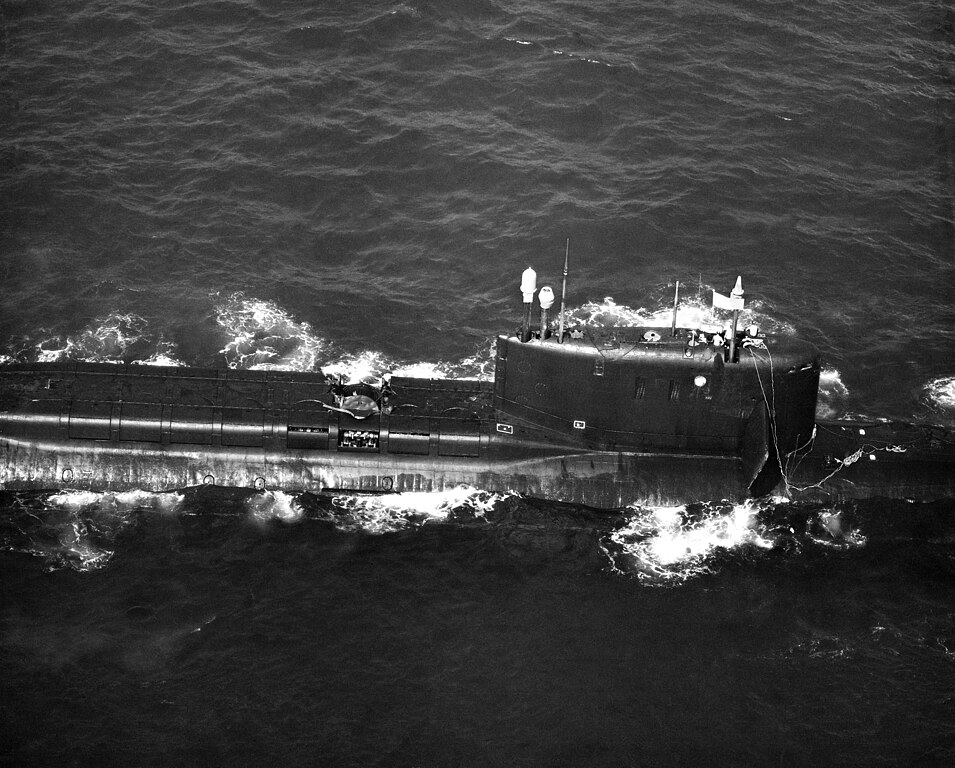

Author’s illustration
⚙ specifications Yankee I |
|
| Displacement | 7,700 tons Surfaced, 9,300 tons submerged |
| Dimensions | 132 x 11.6 x 8m (433 x 38 x 26 ft) |
| Propulsion | 2x shafts VM4 pressurized water cooled reactors, 4 steam turbines |
| Speed | Surfaced: 13 knots (24 km/h; 15 mph) Submerged: 27 knots (50 km/h; 31 mph) |
| Range | unlimited |
| Armament | 4 × 533 mm TT, 2 × 400 mm TT 16 × R-27 (SS-N-6 Serb) SLBMs, see notes |
| Underwater max depht | |
| Sensors | RLK-101 Albatros radar, MGK-100 Kerch’ sonar, Zaliv-P ECM suite, MVU-100 Tucha CCS |
| Crew | 120 |
Variants
Series 667A was the most numerous among all Soviet nuclear submarine projects and had a large number of modifications.
SSBNs withdrawn under the SALT-1 agreement were used in a number of experimental projects. Missile compartments were cut out of the SSBNs, and new ones were built in their place, designed to use nuclear submarines as a carrier under the corresponding programs.
Purpose of projects:
Project 667AU “Nalim” – installation of an improved D-5U missile system, 9 boats.
Project 667AM “Navaga-M” – modernization of the K-140 for testing the new solid-fuel rocket R-31.
Project 667M “Andromeda” – modernization of the K-420 for testing the strategic supersonic (M = 2.5-3.0) missile launcher “Meteorit-M” with a range of more than 5000 km.
Project 667AT “Grusha” – modernization of K-253, K-395, K-423 for use as carriers of subsonic strategic cruise missiles C-10 “Granat” launched from a torpedo tube. Modernization was planned for this project, but was not carried out: K-408, K-236, K-399[4].
Project 09774 (667AN) – modernization of the K-411 into a carrier of ultra-small submarines, with the installation of equipment for scientific research.
Project 667AK “Akson-1” and Project 09780 “Akson-2” are successive upgrades of the K-403 “Kazan” for testing hydroacoustic systems of 3rd and 4th generation submarines, respectively.
Yankee-I, project 667А “Navaga” (1967)

Basic SSBN with 16 x Р-27, first to carry SLBMs in the hull and not the sail. Later disarmed, operated as SSNs as per SALT-II, SSNX
Improved Yankee-I 667АU “Nalim” (1975)
16x Р-27U, 13 converted, under Project 667AU “Nalim”, a program started by June 10, 1971 under government decree for a modernized D-5U missile complex upgraded to the R-27U missiles with an increased flight range of up to 3000 km. In December 1972, the 19th Division received the first Project 667AU submarine K-228. It was accepted without signing the State Acceptance Certificate due to unfinished tests of the missile system. Development went on from September 1972 to August 1973, and on January 4, 1974, it officially entered service.
In addition to the increased range, the new R-27U missile (NATO SS-N-6 Mod2/3) carried a “scattering” type MIRV, with three 200 kt warheads without an individual guidance system, or a conventional monoblock warhead for carrier strikes. In addition to the D-5U missile system, the inertial navigation complex “Tobol” was installed on all converted 667AU project boats.
In 1972-1983, the fleet received eight more SSBNs under this upgrade, K-219, K-245, K-241, K-430, K-426, K-444, K-446 and K-451, all modernized under Project 667AU. They received no NATO specific designation and are considered as “Yankee I”.
Yankee-II, Project 667АМ “Navaga-М” (1977)

This variant was tailored to carry the R-31 ballistic missile, first solid-fueled SLBMs. It was designed to be guided by satellite-launcher and strike US aircraft carrier battle groups.
Project 667AM “Navaga-M” only concerned one converted boat, K-140, fitted wit the R-31 developed at the Leningrad Rubin Design Bureau as a first solid-fuel rocket, which presented a lot of advantages, under chief designer O. Ya. Margolin.
What became the sole Project 667AM, was the second ship Project 667A boat, K-140, and due to the greater mass of the solid propellant only twelve silos were installed instead of sixteen. Total displacement increased and she had a reduced length and increased height for the rear CT “hump”. She was converted at Zvezda, Severodvinsk, in 1973 with the first launch of the R-31 taking place on December 26, 1976 in the White Sea. By mid-1990, the then Soviet MoD ordered to dispose of all R-31 missiles by firing them from September 17 to December 1, 1990 and on the 17th, K-140 was sent for displasal, decommissioned.
Yankee Notch, Project 667АТ “Peer” (1977)

SSGN/SSN 32-40x РК-55 (SS-N-21 Sampson): 3 converted + 4 unfinished; Lengthened by 12 metres (39.4 ft) to 141.5 m (464 ft); 8 more torpedo tubes in waist, 1989 (program cancelled)
Project 667AT “Pear” or “Grusha” was designed to fire the subsonic strategic cruise missiles C-10 “Granat”, a modification called “Yankee Notch” ny NATO, in a modernization carried out in Severodvinsk. The 4th and 5th missile compartments were cut out and a new one was welded in place containing eight 533 mm torpedo tubes, launched from an angle, a first, which became standard in USN practice to free the whole forward nose for the sonar. Thyeh had the improved Tobol-667AT navigation system. The modification was aimed at launching up to 32 strategic C-10 Granat missiles, from the eight 533-mm amidship, 5th compartment. But they could also fire launch long-range torpedoes and mines from the same tubes.
In total, three were converted under Project 667AT:
K-253 which entered service in 1969, modernization was completed on December 20, 1988[3];
K-423 modernized in 1986. Disposed of in 2003 at the Nerpa plant. Her CT became a memorial at the secondary school No. 15 in Krasavino, Vologda Oblast.
K-395 was modernized 1991 and like her sisters was part of the 24th submarine division, Northern Fleet. She was only discarded by September 1, 2002, the longest Yankee class in service ever.
Yankee Sidecar, project 667М “Andromeda” ()

SSGN 12x P-750 Мeteorit (SS-NX-24 Scorpion): 1 converted, delivered as an attack sub due to missile program cancellation. 153 m (502 ft) long, 13,650 tons full displacement
Project 667M “Andromeda” development started on December 9, 1976 to launch the new supersonic (Mach 2.5 to Mach 3) Meteorit-M missile coupled with the the ZM25 cruise missile, range 5000 km+. This was the result of strategoic considerations about the ASW depth of US defense and location of possible targets.
Design Work was carried at the V. N. Chelomey design bureau and coupled with the subsonic strategic cruise missiles C-10 “Granat” launched from torpedo tubes.
Tests were performed at Severodvinsk in 1980-1985, and K-420 was converted, her 4th and 5th missile compartments cut out, new section of three compartments installed with 6 containers for supersonic missiles on either side. The first launch was in the Barents Sea on December 26, 1983. In 1984, 21 test launches were done, and by the early 1990s, work was stopped as they were better alternatove. From 1991 to 1994, K-420 served as torpedo boat only in the 24th submarine division as per SALT/START reductions.
Yankee Pod 667АК “Аxоn-1” (1984)

This was a conversion to test a towed array sonar and new fixed sonar pod as well as other sensor systems: A single was converted, K-403 “Kazan”. Her tailfin-pod was similar to those of the Sierra class SSNs. Project 667AK “Axon-1” started development in 1979-1983, and tests of the Skat-3 sonar system was useful for 3rd generation nuclear submarines.
Yankee Big Nose Project 09780 “Аxon-2” (1996)

This was a unique SSAN with a new type or towed array sonar, Irtysh-Amphora spherical array one one converted and one more unfinished (K-415). “Axon 2 was basically a further modernization of the same K-403 “Kaza” which Tail was tailored as the Project 667BDRM (Delta IV) and 949А OSCAR class submarines. Its Irtysh-Amphora system was installed later on the lead boat of the Yasen-class;
This was to the benefit of 4th generation submarines in 1985 by Rubin Central Design Bureau, conversion starting on August 6, 1987 at Zvezda but in 1988, to reduce costs, an adjusted was made after the completion of tests of the Axon-1 program with work on K-415 stopping, K-403 modernized under the 1991-1995 improved Akson-2 project and by 1996–2000, she became a test hulk until decomissioned on December 9, 2005.
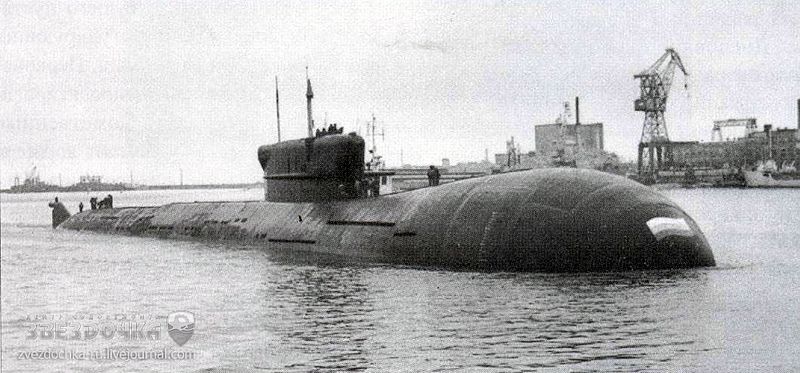
This development did not have any successor due to the lack of funds adn end of service was linked to the Aksona nuclear power plant being no longer supported. She was decidedly too old and obsolte in all aspects. For trouble-free operations it was decided safer to left her static. By April 2009, her spent nuclear fuel was unloaded and she was dismantled at the Kazan facility whhen a fire broke out, with little consequences (see K 403 career).
Yankee Stretch 09774/667АN (1991)

“Research” Submarine for the Losaryk-class midget submarine: 1 converted (K-411), 160 m (520 ft) long. Stated to be an oceanographic vessel, but believed to be a spy sub similar to USS Jimmy Carter.
Project 09774 (667AN) concerned the single KS-411 “Orenburg” in 1990, a modernization completed to carry midget spec ops submarines, supported by a new compartment swapped for the fifth missile compartment and she ended 162.5 m long, hence NATO’s “stretch”. Autonomy was increased and she had accomodation for extra spec ops operatives and personal. This was done in Zvezda from October 1983, but she really was completed by June 1990 and commissioned on 1991, disposed of in 2009.
General Assessment
Project 667A boats became popular between theur appareance and internal comfort and design, and were quickly dubbed “Vanka Washingtons” for their external resemblance to the George Washington SSBN. Later, when the Lafayettes and Ohios appaeared, they were simply called “Azukhs”, more or less a deformation in Russian of “Yankee”.
As part of the Northern Fleet, Project 667A ships entered the 19th and 31st divisions. Gradually, with the increase in the number of Project 667A ships, their patrols started along the Pacific coast of the United States.
The Yankee-class were numerous enough to be assigned to three oceans and fleets: Atlantic, Pacific and Arctic, provinding the bulk of Soviet deterrence for a decade, roughly 1965-75 before gradually replaced by more and more improved Project 667 SSBNs (NATO Delta series), a building process over 30 years. In the 1970s, three Yankee-class were continually on patrol in what was called at the time the “patrol box” in the Atlantic east of Bermuda, and off the US Pacific coast. The USSR saw this was at last the right balance to counter US, British and French nuclear warheads in Western Europe and SSBNs between the Atlantic and Mediterranean. The lead boat K-137 “Leninets” was honored by this name on 11 April 1970, 2.5 years after commission.
What brought to the table these new SSBNs was not only a fully balanced deterrence compared to the US, both in quality and numbers, a continuous presence, and decades of service that allowed design bureaus to plan for the next generations on the very same basic design. Indeed the next Delta I (Project Pr.667B Murena) were directly based on the Project 667AM. This enabled gradual improvements over the years, mostly revolving around new, longer range and more accurate ballistic missiles as well as improving acoustic stealth. Despite all their brillance and acoustic coating, the Yankee were assessed by NATO as “crude, noisy, with short range innacurate missiles”. Despite of this, on the Soviet perspective, they were a fformidable leap forward that was taunted by propaganda. There never was shortage of candidates for the prestigious SSBN branch of the Soviet Navy after the new type showe dits overall reliability.
Albeit the class was clearly more advanced and all issues with previous Hotels/November/Echo class had been ironed-out there was at least one drama, at least official. K-219 indeed was lost on 6 October 1986 after an explosion and fire on board whike in patrol off Bermuda. The epxlosion caused gradual flooding so she sank, but slowly enough for the crew to escape, and still having four crew dead in the fire. The events surrounding this loss continue to be controversial up to this day. At least another boat was involved in a collision with a U.S. Navy nuclear submarine at least on the Russian official version. Still, this was far better in proportion than any class that came before them. The Project 667 Boats were no longer derided as “widowmakers”.
Because of their increasing age however, and while negotiating the SALT I, START I and START II treaties of nuclear weapons reductions between the United States and the Soviet Union, all were disarmed, decommissioned and sent to dedicated nuclear scrapyards, the derived variants (see below) however lingering for some more years. Only a few “Yankee” operated as SSNs and for a short time. Compared indeed to the latest Soviet SSNs in the 1980s they were not agile and noisy. The idea was to maintain them in case a war would broke out or a new “cold”, to convert them back as SSBNs if needed.
The introduction into service of US Navy improved Polaris A-3 missiles with a maximum firing range of 4,600 km, and deployment in 1966 of a program to create a new Poseidon C-3 ballistic missile with even better characteristics required a response to improve Soviet SSBNs. The idea was equipped these with more advanced missiles with, increased numbers and firing range. The first of this long ineage up to the Delta IV started at the Arsenal Design Bureau 5MT later in charge of the D-11 complex (R-31 missile for the 667AM).
In parallel was developed a modernized D-5U complex (R-27U missiles, range 3000 km) from 1971 with a MIRV as project 667AU “Burbot”. It featured noverlties such as the NK “Tobol” inertial system, and lower acoustic signature while other boats were modernized under Project 667AU in 1972-1973 with the The R-27U missile. This, in the end, created a highly effective naval strategic nuclear deterrence system comparable to Polaris but these were still noisy and with low voltage, poor accuracy and range for the D-5 and D-5U which brought them dangerously close to the United States coast.
Every year six boats were transferred between fleets to complete 590 combat patrols. With the Soviet-US agreements in arms reduction modernization projects multiplied but they were considered “spent” in the later 1980s. Experimental boats were for the last, discarded in the mid-2000s.
An industrial Challenge: Dismantling & recycling Project 667A Boats
Despite the fact that a number of Government documents have been adopted, which provide for the transfer to the State Committee for Defense Industry, the Ministry of Atomic Energy, and the Ministry of Economy of operations for the disposal and management of radioactive waste (including spent fuel) generated as a result of disposal, the full gravity of the problem of dismantling nuclear ships lies with the Navy, which owns most of them and is responsible for their safety.
This situation persists for several reasons. Firstly, the Navy, despite its problems, is in no hurry to part with ships for free, for which the military department once paid industry.[29] Secondly, the ministries of industry, which the government obliged to deal with disposal, currently do not have the forces and means to unload spent nuclear fuel from reactors, its temporary storage and transportation; storage facilities (locations) for long-term storage of reactor compartments and large-sized SRW; technological and technical capabilities, production capacity for rapid shipbreaking. This leads to the fact that the recycling process is delayed, and the accumulation of slop ships continues.
Economic aspects of recycling:
According to the Decree of the Government of the Russian Federation No. 514 of 1992, experimental work on the comprehensive dismantling of nuclear submarines was to be carried out on the basis of self-financing of enterprises (with the exception of the costs of cutting out reactor and missile compartments). Ship repair and shipbuilding enterprises were allowed to attract commercial organizations, as well as foreign investors, for recycling work on a contractual basis. Until March 1995, the Russian Ministry of Industry and the Armed Forces had quotas and licenses for the sale of recycling products on the foreign market, as well as benefits for the payment of import and export duties.
It should be noted that government programs provide for the self-sufficiency of the recycling process, i.e. factories (or other structures involved in recycling) must make a profit from the sale of metal (mainly to foreign firms). Zvezda when selling the dismantlement products of the first nuclear submarine of Project 667A (Yankee class, K-241, serial number – 462), despite receiving customs benefits and special export rights, suffered losses in the amount of 311 million rubles in 1993 prices. Similar data, taking into account inflation, were obtained during the disposal of the second building. From the dismantling of ship equipment on the first boat, 60 tons of copper scrap, 100 tons of lead scrap, and 20 tons of aluminum scrap were sold on the domestic market.
The plant must cover the costs of disposal from the metal it receives, although in practice this is an unprofitable activity and part of the costs is covered by the state.
During the complete dismantling of the Project 667A nuclear submarine (Yankee class), more than 3,500 tons of scrap steel were recovered. Of these, 300 tons of stainless steel, 1100 tons of low-magnetic steel, 1900 tons of scrap without grade. In addition, 322 tons of non-ferrous scrap are extracted, of which copper – 50 tons, brass – 70 tons, bronze – 70, copper-nickel – 30, aluminum – 5. During the disposal of Project 667B (Delta-I class), 2096 tons of steel scrap and non-ferrous metals were obtained. Of these, 554 tons of stainless steel, 220 tons of non-ferrous metals, 90 tons of titanium alloys, 95 tons of copper and 58 tons of bronze scrap.
The sale of titanium scrap, which is obtained by cutting nuclear submarines with titanium hulls at the Sevmash Production Association, is unprofitable. Customs duties for 1 ton of titanium scrap are set at US$1,900, and the proposed selling price is only US$1,000. Under these conditions, it is more expedient to process titanium scrap for use for your own needs. The adoption of the decree of the President of the Russian Federation in March 1995 regarding the abolition of customs benefits practically deprives enterprises of the opportunity to work with foreign partners and partially cover their losses. Today, PA “Sevmash”, without the rights of a special exporter and customs benefits, due to the impossibility of selling dismantlement products of the nuclear submarine pr.705 (Alpha class, K-463, serial number 915), has its own costs of 1 billion rubles. And this happens despite the fact that real profit from the sale of metal recovered during recycling can only be obtained through export.
Today, people abroad are interested in non-ferrous metals (cables) and equipment (pumps, compressors, etc.). Submarine hull steel with impurities (in the form of welds on a durable hull) is currently of interest only to China, Finland and Greece, due to technological difficulties in remelting.
Cutting up several nuclear submarines with hulls made of titanium alloys showed that this measure is more expensive than dismantling nuclear submarines with steel hulls. Titanium submarines require more time and more advanced equipment. Moreover, titanium is still considered a strategic raw material and is likely to be used for the needs of the defense complex.
The existing experience of dismantling nuclear ships shows that this event is unprofitable and that the sale of metal covers only part of its costs. Thus, Russian state institutions or commercial structures must be prepared to finance this process.
 K-137
K-137
K-137 was the first 667A boat (later 667AU), laid down at SEVMASH, Severodvinsk on November 4, 1964, launched on September 11, 1966 and completed, commissioned on November 6, 1967, Decommissioned April 3, 1994, sold for for scrapping. No logs yet.
 K-140
K-140
K-140 was a Project 667A, later 667AM boat made at SEVMASH, Severodvinsk, laid down on September 19, 1965, launched August 23, 1967 and commissioned on December 30, 1967, Decommissioned April 19, 1990, sold for scrapping. Ordered originally on January 21, 1965 she entered service abnd by January 11, 1968, was assigned to the 31st Division of the 12th Submarine Squadron, Northern Fleet, based at Sayda Bay. On August 27, 1968 in Severodvinsk, just after modernization was completed, she had a left nuclear reactor leak. There was a lifting of the control bars onto the upper end switches, and a 18 times normal power surge, with pressure and temperature exceeding all norms four times. At the same time, controls were turned off while there was none on duty so no signs of an emergency. This spontaneous surge was an incorrect installation of the power supply network and as the enquiry stated later, multiple errors of maintenance personnel. The core and whole compartment were so irradiated they had to be replaced. No official data of radiation levels or personnel exposure was ever released but there were no official casualties among personel.
On December 20, 1968, she fired a salvo of 8 missiles for the first time, also for the Soviet Navy.
However the 6th missile deviated from course and fell 50 meters from the target, which at 3500 km away on training ground near Norilsk was not a massive issue.
On November 14, 1971, K-140 started a major overhaul at Zvezda, Severodvinsk and repairs after the failure of the port side reactor. It was replaced and later sunk in the Kara Sea.
On November 4, 1972, she was converted as a Project 667AM Navaga-M boat with the D-11 complex, R-31 missiles, down to 12 silos and the associated “hump” raised.
On September 4, 1976, K-140 started her test campaign, until October, led by Deputy Chief Designer E. A. Gorigledzhan. The full crew of engineers and sopecialist reached 400 on board instead of the usual 120. She made her first launch on December 21, at Kandalaksha Bay in the White Sea from under 50 meters at 5 knots.
In 1977, she made a six missiles salvo. From June 1977 to February 1978 she received various fixes and homeported to Yagelnaya Bay. In 1978, she made 7 missile launches, all successful. In the summer of 1979 she was back at Zvezda for fixes, and by September passed state tests.
From 1980 to 1988, K-140 made 8 long test cruises and carried out 5 missile firing tests, being twice awarded the prize for missile training. From September 14 to December 2, 1980 she made her first Atlantic deployment and another from April 2 to June 17, 1981.
However on October 22, 1984, in Motovsky Bay, she collided with K-373 in poor visibility but only had light hull damage.
In December 1984, she made another Atlantic deployment under Captain 1st Rank A.N. Kozlov and later 2nd rank A.G. Lashin, 3rd rank S.N. Egorov.
She was back home in early 1985 and her first commander, which made a hart attack and stayed in command was awarded the Order of the Red Star. In 1989, she was scheduled for completing her service, decommissioned on April 19, 1990, and from September 17 to November 30, she made four trips at sea to dispose of 16 R-31 missiles simply by firing them at short distance. Laid up in Severodvinsk she was stricken in 1997 and scrapped, some relics kept in the Zvezda Museum.
 K-26
K-26
K-26 was a project 667A from SEVMASH, laid down on December 30, 1965, launched December 23, 1967 and commissioned on September 3, 1968, decommissioned July 17, 1988.
 K-32
K-32
K-32 was a Project 667A boat from SEVMASH, Severodvinsk laid down on February 25, 1966, launched April 25, 1968 and commissioned on October 26, 1968, decommissioned April 19, 1990..
 K-216
K-216
K-216 was a Project 667A boat at SEVMASH, laid down on June 6, 1966, launched August 6, 1968, commissioned December 27, 1968 and decommissioned in 1985.
 K-207
K-207
K-207 was a project 667A boat from SEVMASH, laid down on November 4, 1966, launched September 20, 1968 and commissioned on May 30, 1968. She was decommissioned May 30, 1989.
 K-210
K-210
K-210 was a project 667A boat from SEVMASH, laid down on December 16, 1966, launched December 29, 1968 and commissioned on August 6, 1969. She was decommissioned July 17, 1988.
 K-249
K-249
K-249 was a project 667A boat from SEVMASH, laid down on March 18, 1967, launched March 30, 1969 and commissioned on September 27, 1969. She was Decommissioned on July 17, 1988.
 K-253
K-253
K-253 was a 667A boat, later 667AT, laid down at SEVMASH, Severodvinsk on June 26, 1967, launched on June 5, 1969 and completed on November 28, 1969.
On November 28, 1969, she entered the 31st Division of the 3rd Submarine Flotilla, Northern Fleet. From December 1975 to February 1977, she was in overhaul at Zvezda, Severodvinsk.
In November 1989, she was reassigned to the 24th division, 3rd submarine flotilla, Northern Fleet.
On September 1, 1994, she was decommissioned and laid up, then scrapped from 2004, at Nerpa shipyard.
 K-395
K-395
K-395 was a Project 667A, later 667AT from SEVMASH, laid down September 8, 1967, launched July 28, 1969 and commissioned on December 5, 1969.
 K-339
K-339
K-339 was a Project 667A from Leninskiy Komsomol Shipyard, laid down February 23, 1968, launched June 23, 1969, commissioned on December 24, 1969 and decommissioned April 19, 1990, sold for BU.
 K-408
K-408
K-408 was a 667A and later 667AT boat made at SEVMASH, Severodvinsk, laid down on January 20, 1968, launched September 10, 1969 and commissioned on December 25, 1969.
On January 5, 1971, she left Yagelnaya Bay and circumnavigated the world through the Atlantic and Pacific until reaching Krasheninnikov Bay on March 19, 1971, the second of such trips by a submarine in the history of the Soviet Navy under Captain 1st Rank V.V. Privalov, senior commander Rear Admiral V.N. Chernavin. She was assigned in March 27 in the Red Banner Pacific Fleet at Vilyuchinsk.
On November 1, 1973, she was awarded the pennant “For courage and military valor” and in 1974, at the Pacific training site off Kamchatka, collided with USS Pintado.
On July 8, 1983, she was in drydock, converted as a Project 667AT “Grusha” at the Zvezda but apparenbtly all work was stopped and she was never back in service, instead, she was decommissioned on July 17, 1988, and BU in 1994-1995.
 K-411
K-411
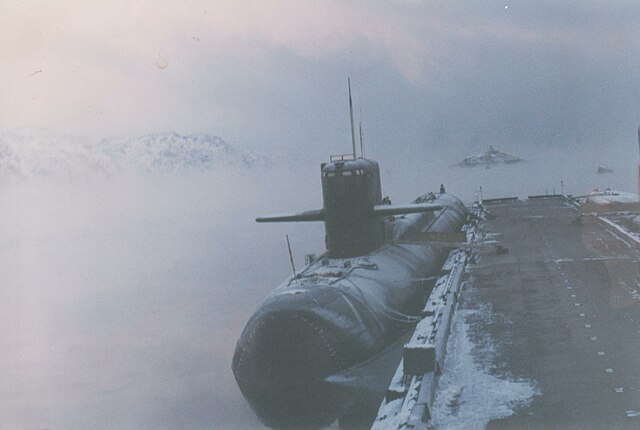
K-411 was ordered on June 21, 1967 as a 667A boat and later converted as 667AN, at SEVMASH yard 430, Severodvinsk, laid down on May 25, 1968, launched January 16, 1970 and completed on August 31, 1970. On September 25, 1971, she enters the 31st Division, 3rd Flotilla, Northern Fleet. In April 1972, she is awarded the MoD Pennant “For Courage and Military Valor.” By July 25, 1977, she is assigned for reconversion as projet 667AN cruise missile conversion as per the SALT-1 treaty reduction, to carry a spec cops midget submarine at Zvezdochka in October 1983, completed as BS-411 and accepted into service in 1991, assigned to the 29th separate submarine brigade. Her 5th missile compartment was replaced by a housing with “research” equipment and new living quarters and she ended lengthened to 162.5 m and having more range and autonomy, extra supplies, improved living conditions. Sevmashpredpriyatie PA manufactured the new hull block.
On September 8, 1998 she was renamed “Orenburg” and in 1999, the Orenburg Oblast necame its patron. After a serie of classified mission she was disposed of at Zvezda on January 17-18 2009 and her dismantlting started when remaining rubber coating caught fire. The process of recycling and storage is now over.
 K-218
K-218
K-418 was a Project 667A boat from SEVMASH, laid down June 29, 1968, launched March 14, 1970 launched on September 22, 1970 and decommissioned on March 17, 1989.
 K-420
K-420
K-420 was a project 667A boat, later 667M. She was from SEVMASH, Severodvinsk, laid down on October 12, 1968, launched April 25, 1970 and commissioned October 29, 1970.
 K-423
K-423
K-423 was a project 667A boat, later 667AT from SEVMASH, laid down January 13, 1969, launched April 7, 1970 and commissioned November 13, 1970.
 K-434
K-434
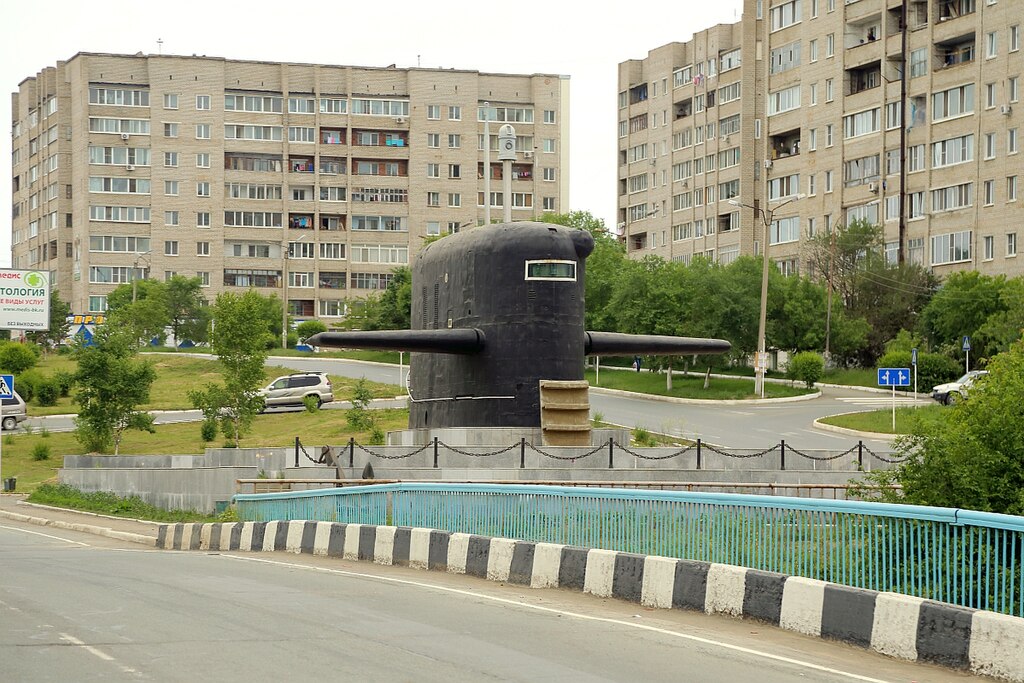
K-434 was a Project 667AU boat from Leninskiy Komsomol laid down on February 23, 1969, launched May 29, 1970, commissioned on November 30, 1970 and decommissioned March 17, 1989.
 K-426
K-426
K-426 was a Project 667A boat from SEVMASH laid down on April 17, 1969, launched August 28, 1970, commissioned on December 22, 1970, decommissioned April 19, 1990.
 K-236
K-236
K-236 was a project 667AU boat from Leninskiy Komsomol laid down on November 6, 1969, launched August 4, 1970, commissioned on December 27, 1970 and decommissioned on September 1, 1990.
 K-415
K-415
K-415 (later reclassified as 667AK-2) was built at SEVMASH, Severodvinsk, laid down on July 4, 1969, launched September 26, 1970 and completed on December 30, 1970
On 1968 June 26 alreadu she had been ordered, with her crew, after formation and training, temporarily became part of the 339th brigade. In Sept. 1970 a second crew from K-48, project 675 was reorganized to be part of K-415 before even launch. By December 2-5 1970 she completed both her state sea trials and missile and torpedo firing qualifications. In January 1971 she sailed from Severodvinsk to Saida Bay, as permanent base, joining the Red Banner Northern Fleet, 31st Division, 3rd Submarine fleet at Yagelnaya Bay (Gadzhievo, Murmansk region) and in August she met her second crew for permanent deployment now from Krasheninnikov Bay (Vilyuchinsk), versed into the 8th division until 1973. Until October she trained, and in 1972 January-March under command of Capt. 1st Rank A.D. Javakhishvili she made her first transoceanic voyage from Saida Bay to Krasheninnikov Bay via South America (Drake Passage), joining the Red Banner Pacific Fleet with the 8th Division of the 15th Special Submarine group at Krasheninnikov Bay. In 1973 she test-launched missiles on her intended combat patrol route as soon on admiralty orders.
In Nov. 1975 she sailed to the Zvezda Yard at Bolshoi Kamen for a first overhaul between March 1976 and August 1977 and in July 25, 1977, was eeclassified as a guided missile submarine. She only resumed service in 1980 and in Nov. 1981 changed assignation to the 21st Div. 4th sub. brigade at Pavlovsky Bay but by May 1987 she was declassified as a special purpose submarine as KS-415 under project 09780 in drydock at Zvezda, but work was soon stopped. She was decommissioned on 1988, July 17 and in September 1992 laid up in Chazhma Bay, Pacific Fleet and by March 2004 pkaced in disposal, BU and recycled at the facility in 2011 at Zvezda, sensible elements treated and removed in 2020 for long-term storage.
 K-403
K-403
K-403 was ordered as a 667A boat, later 667AK-1 at SEVMASH, Severodvinsk, laid down on August 18, 1969, launched on March 25, commissioned on 1971 August 12, 1971. In 1975 she suffered an accident while in powerplant repairs. Batteries exploded but she was fully repaired. Until 1979, she made 7 service cruises was part of the 19th division, based at Yagelnaya Bay in Gadzhievo.
In 1980-1983, she was fitted with test hydroacoustic systems and in 1983, conversion completed as project 667AK “Akson-1” with the SAC Skat-3, 3rd generation nuclear submarines.
In 1996 she was reconverted under project 09780 “Axon-2”, testing 4th generation systems until 2000, making 11 test sorties. She was decom. and stricken in 2004, her flag was transferred to the museum. She broken up at Zvezda. In April 2009 a fire broke up but was mastered, and in 2010 her conning tower was transported to Kazan and became a memorial at Victory Park. Torpedoes were installed next to it, from a military unit at Zelenodolsk.
 K-389
K-389
K-389 was a Project 667A from Leninskiy Komsomol, laid down July 26, 1970, launched June 27, 1971, commissioned November 25, 1971, decommissioned April 19, 1990.
 K-245
K-245
K-245 was a project 667AU made at SEVMASH, laid down on October 16, 1969, launched August 9, 1971, commissioned December 16, 1971 and Decommissioned March 14, 1992.
 K-219
K-219
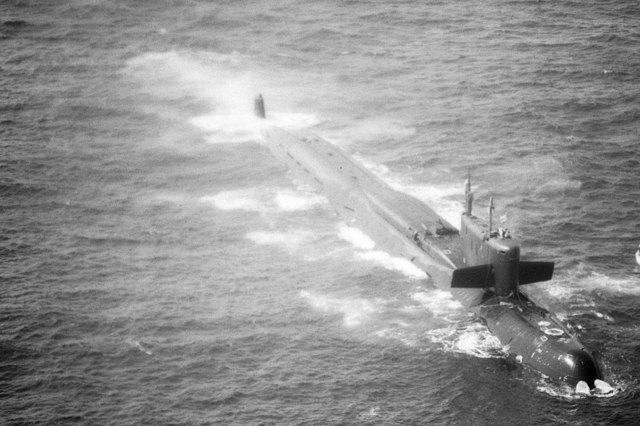
K-219 was a Project 667AU boat from SEVMASH, laid down May 28, 1970, launched October 8, 1971 and compleyed on December 31, 1971. On February 8, 1972, she entered the Northern Fleet, based in Gadzhievo. In 1975, she was modernized under project 667AU “Nalim” with another major overhaul in 1980.
In 1975, her D-5 launchers were upgraded to D-5U with the MIRV capable RSM-25U missiles but she was remembered for her accidents:
On August 31, 1973, the seal of missile silo No. 15 leaked, sea water started to flood it, reacted with nitrogen dioxide already leaking and the resulting corrosive nitric acid damaged the fuel lines, ended in a explosion of when the compound self-ignited by pressure ad heat. One operator died and now open missile silo was completely flooded. Back to port sjhe was repaired but not the silo whixh was simply plugged shut.
On September 4, 1986, K-219 Gadzhievo and headed to the US East coast for a patrol duty with 15 nuclear missiles on board and under captain 2nd rank Igor Britanov, senior assistant Sergei Vladimirov, missile weapons officer Alexander Petrachkov, powerplant officer Gennady Kapitulsky, and political officer Yuri Sergienko and in all 12 officers out of 32 changed as well as 12 out of 38 midshipmen. Shortly after diving in the Barents Sea, a leak opened in silo No. 6, but officer Petrachkov, did not report this to commander Britanov. It was detected during a control way before but the boat was under orders to proceed to her patrol position. The malfunction notice was removed, unreported and excess water was simply drained out. However Between UK and Iceland, while proceeding to the infamous GIUK gap, K-219 was detected by SOSUS by the US Navy. Commander Britanov unsuccessfully tried to avoid detection by camouflaging himself in the noise of a cargo ship and devade seabed buoys. On October 3, arriving in the assigned patrol zone 680 miles northeast of Bermuda she was detected by the Los Angeles-class submarine USS Augusta (SSN-710) on collision course.
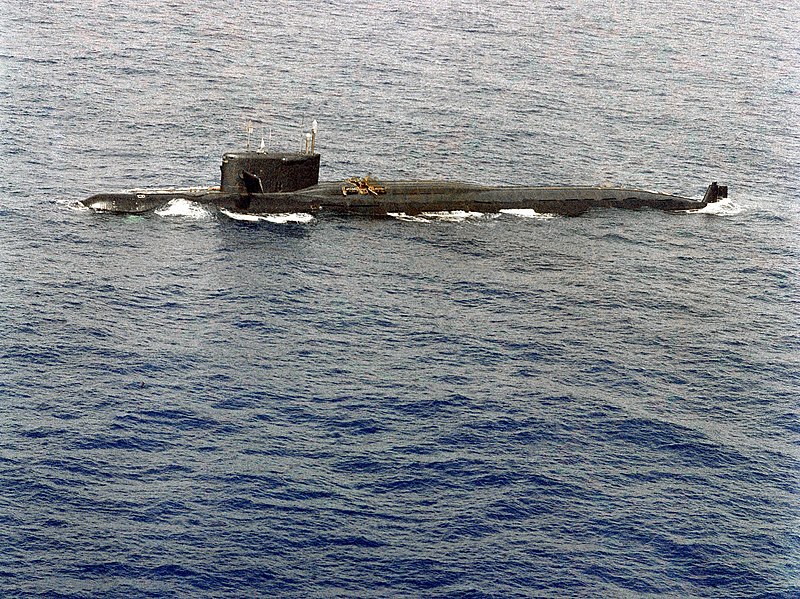
On October 3, the silo officer was forced to pump water out of silo No. 6 twice a day and more, but in the morning, in a test maneuver the US called “Crazy Ivan”, missile silo No. 6 completely depressurized, water flooded in. Attempts to pump out this extra seawater failed, and the same events as in 1973 repeated, when the explosive mixture of rocket fuel developed. Only then weapons officer Petrachkov reported the incident developing and recomender to rise to 50 m, fill the missile silo with water, fire it with emergency launch of the main engines. It was approved but took 5 minutes to fill the silo and in betwee, the mixture exploded. It destroyed the outer wall of the pressure hull and vented out the plutonium warheads with parts dispersed around, whereas poisonous gases entered the silo compartment and further Water entered through a hole on the missile deck. Weighted down, K-219 made a nose dive direct to the bottom under 300 meters, almost pre-crush depth, and at 350 meters, commander Britanov decided to blow out all tanks wheeras propellers were launched in an emergency ascent along a steep trajectory, diving planes up max. Two minutes after the explosion, K-219 spectacularly bursted to the surface.
The crew fled the fourth missile compartment, battening down the sealed bulkheads. Nitric acid did not have time to corrode the rubber seals but toxic gases forced an ebacuation into two independent halves, command and torpedo compartments fwd and medical, reactor, control and turbine compartments at the stern.
Only the starboard reactor provided electricity and basic systems with 30% power. After the emergency rise, the port reactor was in operation at 50% and at the end of the day the starboard side power supply was los and emergency protection of the starboard reactor activated but the control bars did not lowered to the required position, for a sharp increase in emperature of the primary coolant circuit. There was an attempt to shut it down from the control panel but it failed. Only solution was to lower the control bars manually, selecting the doomed crew members which had to enter directly into the reactor compartment using special handles? Unfortunately for them thay had no radiation protection suits as they were separated on the reactor cooling system compartment. Reactor compartment commander, senior lieutenant Nikolai Belikov, and sailor Sergei Preminin did this, in a 70 °C room and before Belikov collapsed, dragged out of the chamber, Belikov and Preminin in turns, managed to lower three of the four control bars, which were bent due to the heat. Preminin re-entered the cell twice to lower the fourth bar and melting of the core was prevented, but he died due the pressure difference, the hatch remained shut. Still the crew had to retreat further aft as toxic gas progressed. Preminin would be posthumously awarded the Order of the Red Star and in 1997 title of Hero of the Russian Federation. Nikolai Belikov was also irradiated and suffered severe consequences, but he died on March 4, 2017.
After surfacing, K-219 established contact with the Soviet frigo ship “Fyodor Bredikhin”, closest to the scene and later joined by the timber carrier “Bakaritsa”, tanker “Galileo Galilei” and bulk carrier “Krasnogvardeysk” ro-ro ship “Anatoly Vasilyev” and since this was close to the US coast, the US Navy tug USNS Powhatan (T-ATF-166) and USS Augusta (SSN-710) offered assistance. The sce,e was flew off and photographed at all angles by a P-3C Orion which remained constantly on the area.
The commander eventually ordered the reactor to be shut, personnel to the deck. The emergency protection of the port side reactor worked in automatic mode and except for six officers and commander, the sailors were transferred to civilian ships around. Fire continued to rage still in the missile and diesel generator compartments while the reactor compartment was inaccessible and fate for those in the aft compartments was still uncertain.
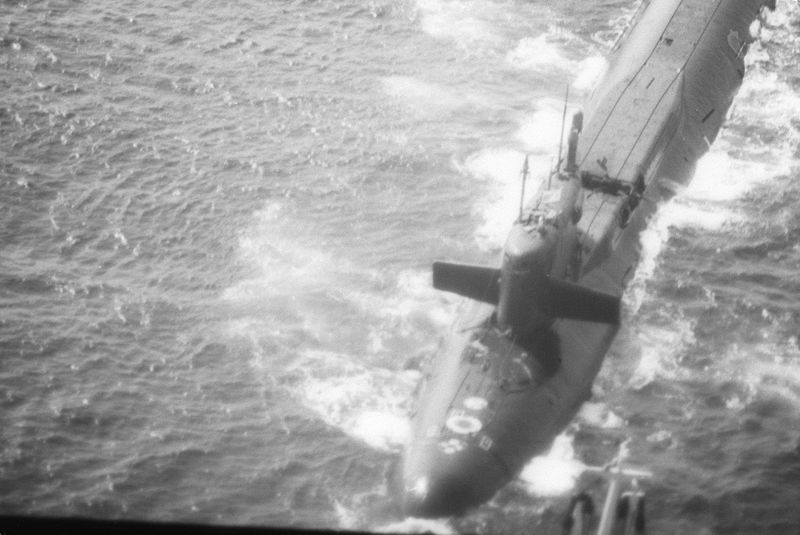
Fedor Bredikhin and Bakaritsa left the scene leaving the US Navy command and the USSR Navy command to decide what next. It was agreed that K-219 would be towed with some crew members of the Krasnogvardeysk and Anatoly Vasilyev, Galileo Galilei to help officers. US help was decided against. From October 3 to October 6, emergency parties fought fire and tried to pump out water in the compartments while the tug was replaced by the bulk carrier Krasnogvardeysk, sending a “tow line” with her anchor chain, manually dragged from bow to stern until connected with a bracket and further secured with two towing ropes between Anatoly Vasilyev and Galileo Galilei to keep course. Later TU-95s came and dropped Containers with spare parts and equipment from Kaliningrad. One of these shattered when hitting water and sunk with its content. Surviving containers were picked up and delivered to Krasnogvardeysk on which more preparations for towing were suspended. However the most important items missing were those that sank to the bottom: The supply of regenerating cartridges. Soviet fighters based in Cuba also flew over to protect K-219 in case. When the P3 Orion returned, it was chased off. As the spread of poisonous gas on board cound not be contained, it was decided to evacuate the crew with only Commander Britanov remaining, guns his hands for a possible capture.
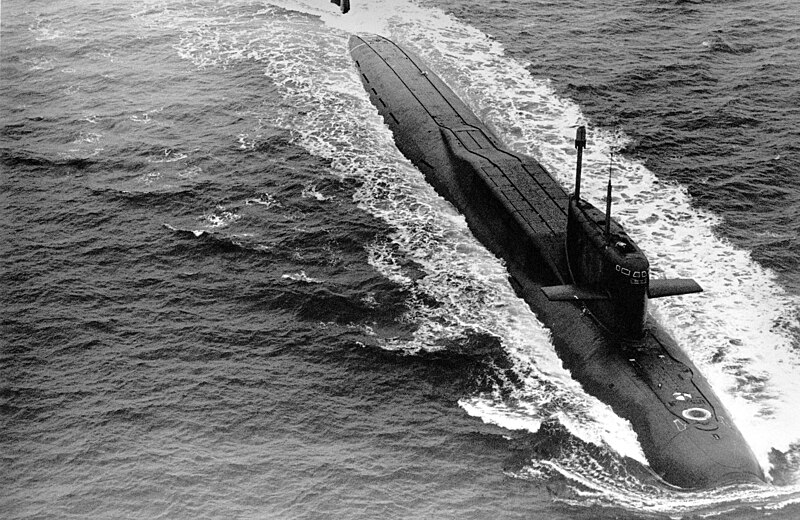
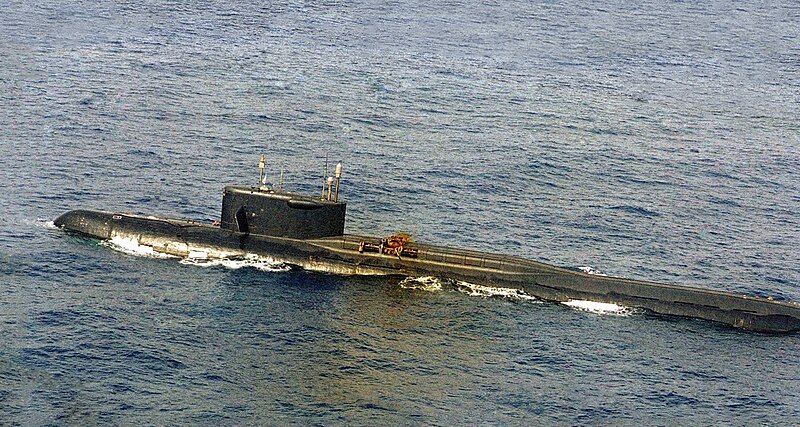
Initially, it was planned tow back K-219 crew to USSR by Krasnogvardeysk, however 115 were evcauated to the ro-ro “Anatoly Vasilyev” to Havana, and by special flight returned to to Moscow.
All this time USS Augusta remained in the immediate vicinity with raised periscope, surfaced and sent a rescue boats and rafts with personal to take close-up photographs. The tug Powhatan was signalled to keep away, as the naval staff feared it would be towed to the nearest US Bermuda base. On the night of October 6, the towing cable broke and water entering the pressure hull passed critical level. At 11:03 on October 6, 1986, K-219 sank on an even keel under 5000m. The commander left on a life raft at the last minute.
The bulk carrier Krasnogvardeysk remained on duty for a week in the area as Crew members measured radioactivity with a dosimeter and monitored the surface for any surfacing sensible item. Radioactivity turned out to be normal and nothing found on surface so she met the nuclear cruiser Kirov, ASW Cruiser Ochakov and a diesel submarine before leaving the area.
In total four members died directly or of exposure, Captain 3rd rank Alexander Petrachkov, sailor Nikolai Smaglyuk, driver Igor Kharchenko, bilge sailor Sergei Preminin.
Four more died later in hostpital, Vladimir Markov (warhead-4 Cdr), Vladimir Karpachev, assistant commander, Igor Krasilnikov, chief mechanical engineer and Raimundas Sadauskas, foreman.
Commander Britanov was trialled in Sverdlovsk until May 1987 but was dismissed under MoD Dmitry Yazov with all charges dropped but he was bar to wear a uniform.
A layer commission in Moscow estimated there was no risk of the hulk for the environment.
A popular version of events, whhich resurface today under Putin’s propaganda is the theory of a ramming by the USS Augusta. Indeed the later was noted while at HP New London Naval Station with bow damage. However the latter explained this was due to a collision with K-279 instead, creating a confusion. About the even the USN had been firmly maintaining there was no collision with K-219. Both sides at the time tried to refrain from mutual accusations.
 K-252
K-252
K-252 was a Project 667A boat laid down at Leninskiy Komsomol on December 25, 1970, launched September 12, 1971, commissioned December 31, 1971 and decommissioned on March 17, 1989.
 K-214
K-214
K-214 was a Project 667AU boat from SEVMASH, Severodvinsk laid down on February 19, 1970, launched September 1, 1971 and commissioned on February 8, 1972, decommissioned on June 24, 1991.
 K-228
K-228
K-228 was a project 667AU SEVMASH, Severodvinsk laid down at September 4, 1970, launched on May 3, 1972, and commissioned on September 30, 1972, decommissioned on September 3, 1994.
 K-258
K-258
K-258 was a Project 667AU boat from Leninskiy Komsomol laid down on March 30, 1971, launched on May 26, 1972, commissioned on September 30, 1972 and decommissioned on June 16, 1991.
 K-241
K-241
K-241 was a Project 667AU from SEVMASH, laid down on December 24, 1970, launched June 9, 1972, commissioned on October 23, 1972 and decommissioned June 16, 1992.
 K-444
K-444
K-444 was a Project 667AU boat made at SEVMASH, Severodvinsk, laid down April 8, 1971, launched August 1, 1972 and completed on December 23, 1972. She was decommissioned on September 30, 1994.
 K-446
K-446
K-446 was a Project 667AU boat built at Leninskiy Komsomol Shipyard, laid down on November 7, 1971, launched on August 8, 1972 and completed on January 22, 1973. She was Decommissioned March 17, 1993.
 K-451
K-451
K-451 was a Project 667AU boat from SEVMASH, Severodvinsk, laid down on February 23, 1972, launched on April 29, 1973 and completed on September 7, 1971, Decommissioned June 16, 1991 for scrapping
K-436 was a 667AU boat made at Leninskiy Komsomol Shipyard, laid down on November 7, 1972, launched July 25, 1973 and commissioned on December 5, 1973, Decommissioned March 14, 1992 for scrapping
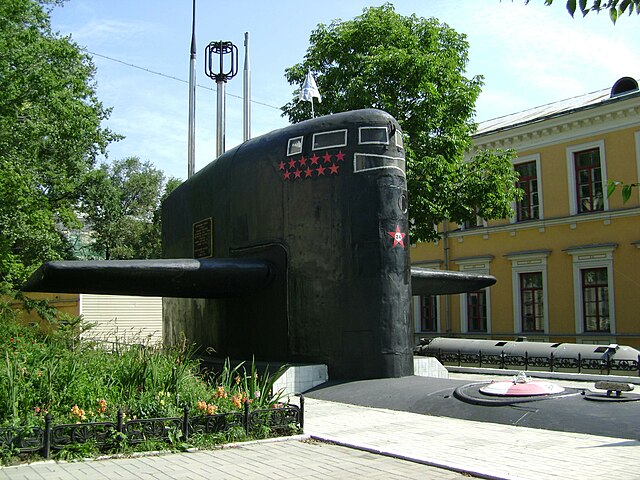
K-430 was the last Project 667AU made at Leninskiy Komsomol Shipyard, laid down on July 27, 1973 and launched on July 28, 1974, commissioned on December 25, 1974 and Decommissioned January 12, 1993, she became a memorial at Vladivostok.
Read More/Src
Books
Conway’s all the world’s fighting ships 1947-95
Jane’s Fighting Ships of the World, 1994.
Links
deepstorm.ru/
hazegray.org
nuke.fas.org
navypedia.org/
On ru.wikipedia.org
on web.archive.org/
nationalgeographic.com k19
en.wikipedia.org Yankee class submarine
web.archive.org/ submarine.id.ru 667a
web.archive.org ruspodlodka.narod.ru
deepstorm.ru/
web.archive.org DeepStorm.files 667A
deepstorm.r 667AT/list.htm
web.archive.org ria.ru
web.archive.org vdvsn.ru/
web.archive.org/ newsofday
web.archive.org k-403
archive.ph/ k415
web.archive.org/ aplsn/index.htm
http://www.armscontrol.ru/subs/snf/snf03221.htm
deepstorm.ru/ k-403.htm
ckb-rubin.ru project_677/
Videos
Model Kits
On scalemates
MikroMir 1:350, Project 667A Navaga Polar Bear 1:350,
3D
https://www.cgtrader.com/3d-model/russian-nuclear-submarine-project-667

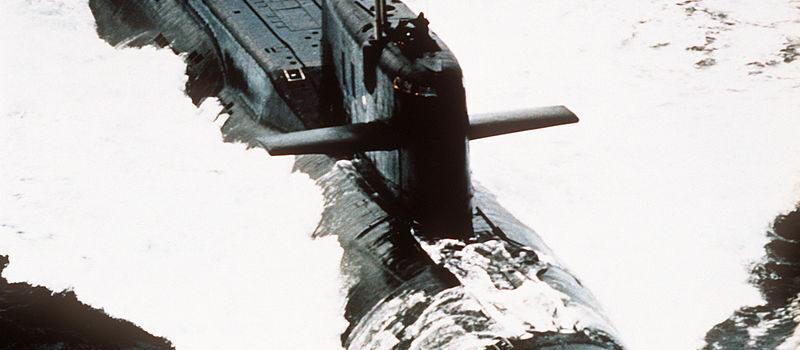

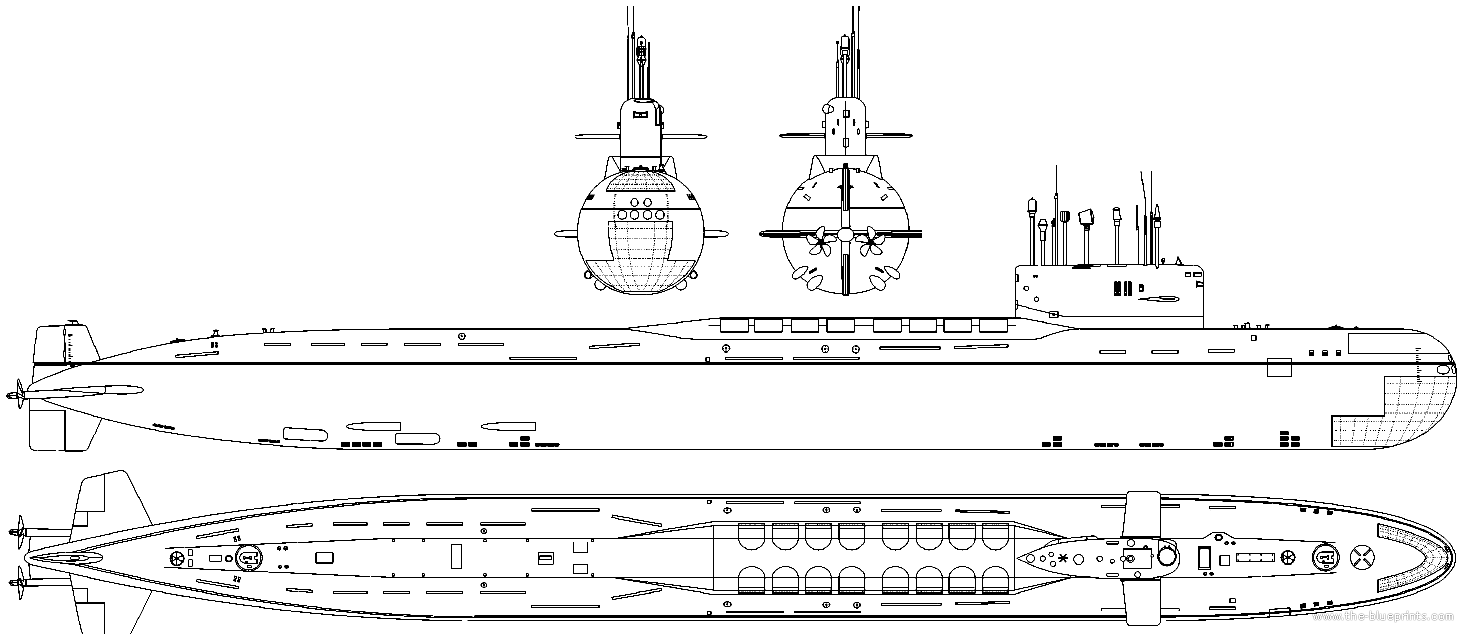
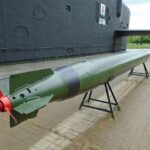
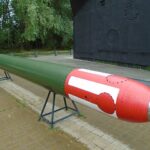
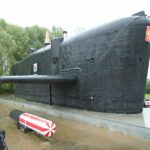
 Latest Facebook Entry -
Latest Facebook Entry -  X(Tweeter) Naval Encyclopedia's deck archive
X(Tweeter) Naval Encyclopedia's deck archive Instagram (@navalencyc)
Instagram (@navalencyc)





 Austrian Navy
Austrian Navy French Navy
French Navy Royal Navy
Royal Navy Armada Espanola
Armada Espanola K.u.K. Kriegsmarine
K.u.K. Kriegsmarine Dansk Marine
Dansk Marine Nautiko Hellenon
Nautiko Hellenon Koninklije Marine 1870
Koninklije Marine 1870 Marinha do Brasil
Marinha do Brasil Osmanlı Donanması
Osmanlı Donanması Marina Do Peru
Marina Do Peru Marinha do Portugal
Marinha do Portugal Regia Marina 1870
Regia Marina 1870 Nihhon Kaigun 1870
Nihhon Kaigun 1870 Preußische Marine 1870
Preußische Marine 1870 Russkiy Flot 1870
Russkiy Flot 1870 Svenska marinen
Svenska marinen Søværnet
Søværnet Union Navy
Union Navy Confederate Navy
Confederate Navy Armada de Argentina
Armada de Argentina Imperial Chinese Navy
Imperial Chinese Navy Marinha do Portugal
Marinha do Portugal Mexico
Mexico Kaiserliche Marine
Kaiserliche Marine 1898 US Navy
1898 US Navy Russkiy Flot
Russkiy Flot French Naval Aviation
French Naval Aviation Russian Naval Aviation
Russian Naval Aviation Sovietskiy Flot
Sovietskiy Flot Royal Canadian Navy
Royal Canadian Navy Royal Australian Navy
Royal Australian Navy RNZN Fleet
RNZN Fleet Chinese Navy 1937
Chinese Navy 1937 Kriegsmarine
Kriegsmarine Chilean Navy
Chilean Navy Danish Navy
Danish Navy Finnish Navy
Finnish Navy Hellenic Navy
Hellenic Navy Polish Navy
Polish Navy Romanian Navy
Romanian Navy Turkish Navy
Turkish Navy Royal Yugoslav Navy
Royal Yugoslav Navy Royal Thai Navy
Royal Thai Navy Minor Navies
Minor Navies Albania
Albania Austria
Austria Belgium
Belgium Columbia
Columbia Costa Rica
Costa Rica Cuba
Cuba Czechoslovakia
Czechoslovakia Dominican Republic
Dominican Republic Haiti
Haiti Hungary
Hungary Honduras
Honduras Estonia
Estonia Iceland
Iceland Eire
Eire Equador
Equador Iran
Iran Iraq
Iraq Latvia
Latvia Liberia
Liberia Lithuania
Lithuania Mandchukuo
Mandchukuo Morocco
Morocco Nicaragua
Nicaragua Persia
Persia San Salvador
San Salvador Sarawak
Sarawak Uruguay
Uruguay Venezuela
Venezuela Zanzibar
Zanzibar Warsaw Pact Navies
Warsaw Pact Navies Bulgaria
Bulgaria Hungary
Hungary

 Bundesmarine
Bundesmarine Dutch Navy
Dutch Navy Hellenic Navy
Hellenic Navy Marina Militare
Marina Militare Taiwanese Navy
Taiwanese Navy Chinese Navy
Chinese Navy Indian Navy
Indian Navy Indonesian Navy
Indonesian Navy JMSDF
JMSDF North Korean Navy
North Korean Navy Philippines Navy
Philippines Navy ROKN
ROKN IDF Navy
IDF Navy Royal New Zealand Navy
Royal New Zealand Navy Egyptian Navy
Egyptian Navy South African Navy
South African Navy

































 RN
RN
 Marine Nationale
Marine Nationale
 Soviet Navy
Soviet Navy
 dbodesign
dbodesign